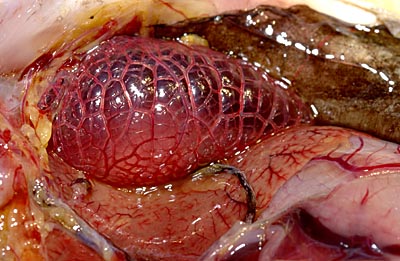

Lung of a bearded dragon
Nikon D1x, AF Zoom Nikkor 24-85mm F2.8-4D(IF), SB-28DX
If you use large number stop (smaller iris), focusing range will be wide. Also using TTL(Through The Lens) light control flash, exposer will be correct on any lens stop.
|
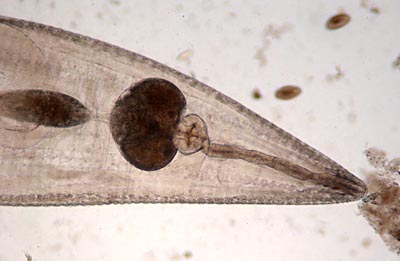

Head part of nematode extracted from bearded dragon feces
Nikon D1x, Olympus DPlan10 Lens:NFK2.5x LD
On microscopic images, quality of objective lens is most effective to the quality of image. If you are planning to take microscopic photographs, using at least curvature of field corrected and chromatic obberation corrected lenses, such as PLAN type lenses, are recommended.
|


Cystolith of a rabbit
Nikon D1x, AF Micro Nikkor 105mm F2.8D, SB-28DX
Single focal(Non-zoom) macro lens is best to use when taking small object images. Single focal macro lens can focus up to equal image size on the film or on the CCD. 1cm object can be imaged about full size on CCD.
|
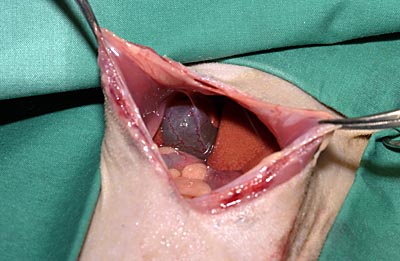

Abdomen of ferret
Nikon D1x, AF Zoom Nikkor 24-85mm F2.8-4D(IF), SB-28DX
Color balance will be fine even under the surgical light if white balance is corrected strictly.
|


Incisor extracted from prairie dog by odontoma
Nikon D1x, AF Micro Nikkor 105mm F2.8D, SB-28DX
Good object for macro lens. To avoid getting too bright or too dark images, it is recommended to take several cut by changing flash amount. Care will be needed especially when the target is whitish or darkish color.
|


Abdominal operation of an iguana (LaserSurgery)
Nikon D1x, AF Micro Nikkor 105mm F2.8D, SB-28DX
You can get best quality image if the iris, focus, exposure, and white balance is correct. This image was taken by F22, manual focus, manual exposure(TTL controled flash), and custom white balance. Note almost every part of field is on focus even it is a close-up shot.
|
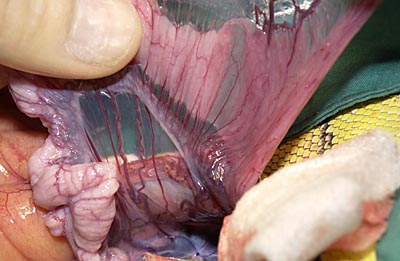

Oviduct of an iguana
Nikon D1x, AF Micro Nikkor 105mm F2.8D, SB-28DX
Membranaceous object is usually diffilut to shoot by its reflection. Care the angle of camera and the object. Another good way to avoid reflection is to separate the flash and place it away from lens axis.
|
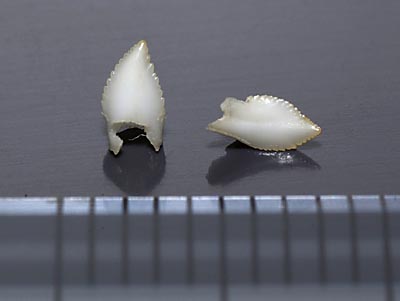

Iguanodon(Teeth of an iguana)
Nikon D1x, AF Micro Nikkor 105mm F2.8D, SB-28DX
1x image by using single focal macro lens. You can enlarge the object this size by using only camera lens. This is the power of single focal macro.
Of course, you have to be strict about the focus. It is easy to focus static object such as this teeth but hard to focus on moving object. Also be sure to correct the exposure when shooting white object by black back or vice versa.
|
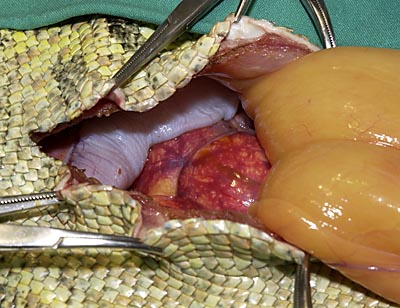

Abdominal operation of an iguana
Nikon D1x, AF Micro Nikkor 105mm F2.8D, SB-28DX
Internal organs of an animal are usually very colerfull and beautiful. We should always be careful to replicate the correct color. Red tissue:ovary, yellow tissue on right:fat.
|


Iguana
Nikon D1x, SIGMA 15mm F2.8 EX Diagonal Fisheye, SB-28DX
Close-up exposure by diagonal fisheye lens. In some occasion, wide lens or fisheye lens are useful to get a close-up. Wide lens usually has deeper depth of field. If you use larger stop number(closing the iris), it can be pan-focused, which will focus several cm from the lens to infinity. This can be used when expecting special effects.
|